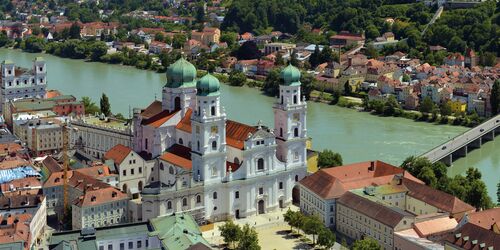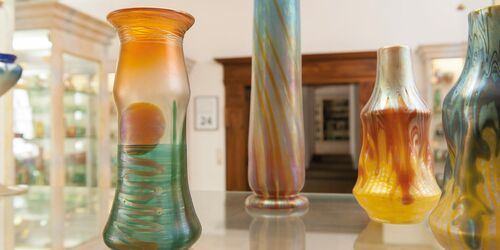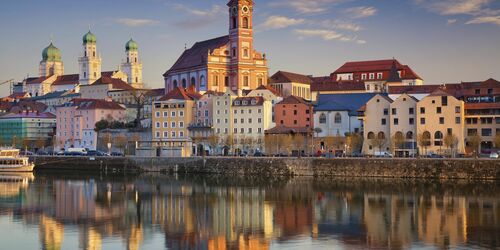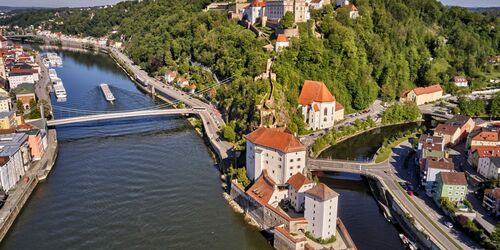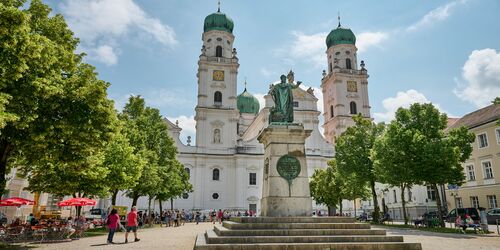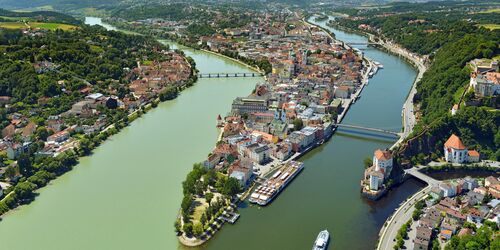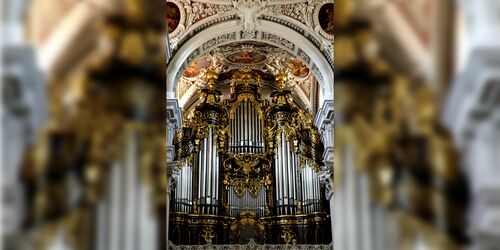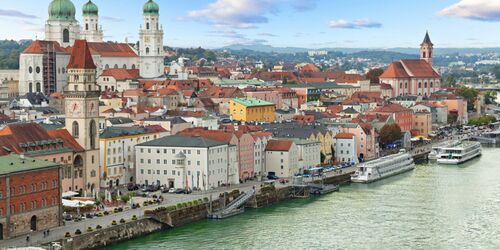
A walk through the Three Rivers City of Passau
Visit the historic baroque city of Passau on the three rivers Danube, Inn and Ilz on an excursion by train. Experience the Mediterranean flair that flows through the small streets and go on a journey of discovery to Passau's most beautiful sights.
Discover the picturesque city of Passau with its impressive architecture, vibrant culture and picturesque landscape. The centre of the old town is characterised by colourful baroque buildings and winding alleys. Passau was almost completely destroyed by the devastating city fire of 1662. In the course of reconstruction, it was mainly Italian artists who renewed the city. This gave Passau its present southern and baroque appearance. With its numerous rivers and boats and its narrow, baroque alleys, Passau is reminiscent of a smaller version of Venice and has therefore been nicknamed the "Venice of Bavaria".
Passau's old town awaits your visit
The starting point for our tour through Passau's winding alleys is the main railway station. The building in classicist style was erected in 1860 and is located in the immediate vicinity of the historic centre of the city. And that is exactly where we are heading now. Via Bahnhofsstraße we head west across Ludwigsplatz into Ludwigstraße. At the historic cistern at the end of the street, we turn into Grabengasse and follow it to Carlonegasse. This small alley takes us directly to Domplatz, where our gaze immediately falls on the façade of Passau's imposing Baroque cathedral.
The sound wonder of Passau: the world's largest cathedral organ
Passau Cathedral has dominated the cityscape of Passau for centuries. The majestic place of worship was first mentioned in a document as an episcopal church in 730 and is still the episcopal seat and main church of the diocese of Passau today. Since the cathedral was almost completely destroyed in the devastating city fire of 1662, it was given its present form by being rebuilt in the Baroque style. The church impresses with its imposing size and its unique architecture, which combines elements of Baroque, Renaissance and Gothic. The cathedral with the largest baroque interior north of the Alps creates a breathtaking atmosphere with its high ceilings and ornate stucco decorations.
A special attraction in the magnificent interior of Passau Cathedral is the world's largest cathedral organ. Over 17,000 pipes produce a majestic sound that astonishes visitors. During one of the many organ concerts, you can experience the energy and grace of the music produced by this impressive instrument. The combination of powerful, majestic sounds and delicate, filigree melodies embedded in the acoustics of the impressive building will leave you in awe. The lunchtime concerts in particular are always worth a visit. From the beginning of May to the end of October, the cathedral musicians let the world-famous organ resound daily at 12:00 p.m. with music from different epochs. You can find the dates here.
Surrounded by magnificent architecture on Residenzplatz
We leave the cathedral and follow Zengergasse to the back of the cathedral on Residenzplatz. This picturesque square, together with the surrounding buildings, is a picturesque ensemble - the Gothic cathedral choir towers in the west, the Residenz with its Baroque façade surrounds the south and the water in the Wittelsbach fountain gurgles in the middle of the square. Around the Residenzplatz, cafés and restaurants invite you to linger and offer a wonderful view of the historic buildings and the hustle and bustle of the square.
The Schaiblingsturm - popular photo motif on the Inn quay
Via Schustergasse, the path leads us further east to the church of St. Michael. We follow the small Schwabgäßchen in front of it to the banks of the Inn. Along the Inn quay to the east, our gaze immediately falls on the Schaiblingsturm. The snow-white round tower with a red roof was built as early as 1250 and has served over the centuries as a defence tower, storage tower, landing stage and accommodation for the Passau Kammerspiele. With its pointed roof, the tower is an absolute eye-catcher and a popular photo motif on the Inn promenade. We pass the tower and follow the Inn to its mouth into the Danube.
The play of colours of the water at Dreiflüsseeck
After about 350 metres we reach the mouth of the Inn. But what awaits us here is far more impressive than a simple river mouth. Here at the Dreiflüsseeck, a peninsula between the Danube and the Inn, is the only place in the world where three rivers coming from three directions join and flow together into the fourth. The different colours and currents of the rivers form a fascinating natural spectacle, for here the water of the black Ilz joins the blue Danube and the green Inn. On our tour of Passau, we now follow the Danube upstream and after about 230 metres turn into Bräugasse.
On the corner of Römerplatz is the Alte Bräuhaus, where we can fortify ourselves for the rest of the way. The Bavarian pub with its historic vaults is located in a former brewery whose history dates back to the 14th century. Today, hearty Bavarian cuisine and local beer specialities are served in the vaults and on the sun terrace.
Insight into history and a view of the Passau region
We continue our walk through Passau and reach the north bank of the Danube via the Prinzregent-Luitpold Bridge, which was opened in 1910. Directly at the crossing, we walk up the Ludwigsteig to the Veste Oberhaus. The medieval castle complex on a hill north of Passau was built in the 13th century and served as an important defence point during numerous wars and conflicts. Veste Oberhaus is also one of the largest preserved castle complexes in Europe.
Today, Veste Oberhaus is a popular excursion destination and houses a museum on the history of the castle complex, Passau and the region. The permanent exhibition "Fascination of the Middle Ages" displays a collection of medieval art, including paintings, sculptures and handicrafts. The museum also houses a large collection of weapons and armour, a section on Passau's urban history and a historical pharmacy.
From the fortress you have an impressive panoramic view of the city of Passau, the three rivers and the surrounding hill country. Above all, you should pay a visit to the 18th century observation tower. In addition to the fantastic view you experience here, the tower houses a multimedia exhibition. It presents the multifaceted history of the German-Austrian border region and explains the important role played by the rivers Inn, Salzach and Danube. Plan enough time, because there is a lot to discover in the Veste Oberhaus.
The town hall square awaits you
We gradually make our way back - downhill the way we came and cross the Luitpold Bridge again. Here we turn west into Fischmarktgasse. After 70 metres we enter Rathausplatz, on the south side of which is the Old Town Hall with its striking Town Hall Tower.
The impressive 14th-century building is a remarkable example of Gothic architecture in the region and has several magnificent town hall rooms that are used for public events and celebrations. One of the most famous rooms is the "Great Town Hall Hall", which with its magnificent ceiling paintings and chandeliers is a popular venue for concerts and festive events.
Directly next to the Old Town Hall, in a baroque building from the 18th century, the Passau Glass Museum is also located. The museum displays an extensive collection of glass objects that give a good insight into the diversity of glass production in Bavaria, Bohemia, Austria and Silesia in the period from 1650 to 1950.
Through the alleys of Passau
From the town hall square, the tour of Passau takes us further into the picturesque Höllgasse. This is where numerous craftsmen's workshops have set up shop and put their craftsmanship on display. The colourful cobblestones that line the path of the alley are repainted every year by artists. At the end of the alley, the Schlosserstiege leads to Steinweg. We follow this to the west to get back to the starting point of our tour. The path changes its name several times and so Steinweg becomes Rindermarkt before it changes into Roßtränke, becomes small Klingergasse and on the last stretch before it becomes Frauengasse, it is called Bratfischwinkel. At Schanzl we return to Bahnhofstraße and thus back to our starting point.
Full of new impressions of the three-river city of Passau, we set off again relaxed by train on our way home. While you're there, you should already start thinking about what you would like to experience on your next visit to Passau. Because with three rivers flowing through it, the city is virtually predestined for an exploration tour by boat. And there are also other attractions waiting to be discovered in the south of Passau. Here, in addition to the Roman Museum, you will also find the pilgrimage church and the Mariahilf monastery, both of which are well worth a visit.
Bahnhofstraße 29
94032 Passau
Passau Hbf (main station)
Our tip: Please make sure to check your train connection and the expected capacity before you start your journey.
